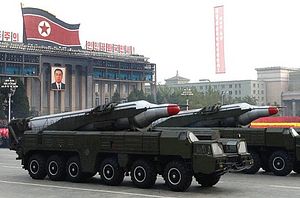Yesterday, North Korea launched two liquid-fueled Musudan (Hwasong-10) intermediate-range ballistic missiles. As I wrote then, the tests marked the fifth and sixth test launches of the missile this year. Testing began in mid-April, to coincide with the birth anniversary of Kim Il-sung, North Korea’s founder and grandfather to current leader Kim Jong-un. Sadly for Kim, all four tests prior to yesterday had failed either at launch or shortly after launch. (The Diplomat‘s John Power has a good round-up of the most recent tests at our Koreas channel.)
Tests one through four failed, and yesterday, the first test (test launch five) also failed, though it flew further than the previous tests. It turns out that the sixth and final Musudan tested to date actually demonstrated results suggesting a high degree of success. Japan’s Defense Minister Gen Nakatani noted an apogee of around 1,000 kilometers for the missile. The sixth Musudan also covered the most surface distance, traveling 400 kilometers from its launch site near the North Korean city of Wonsan, on the country’s eastern coast overlooking the Sea of Japan. (Incidentally, the first missile fired yesterday also flew 150 kilometers, a significant upgrade over the previous launches in April and May.)
The 1,000 kilometer apogee means that the missile made it into the Earth’s exosphere. Long-range ballistic missiles work by essentially hurling their payload high into the earth’s atmosphere, using a ballistic trajectory to reach their target, letting gravity and air resistance do most of the work in the reentry and terminal phases. A Musudan at 1,000 kilometers is a worrisome milestone, particularly if Pyongyang is able to mount its new compact nuclear devices on board the missile. The 400 kilometer range, meanwhile, shouldn’t deceive you; North Korea likely intended for the missile to fly at a steeper angle than would be ideal for it to reach its maximum range of 3,500 kilometers. (Pyongyang took care to make sure that the missile didn’t splash down within Japan’s air defense identification zone, as well.)
Indeed, early on Thursday, a day after the Musudan test launches, North Korean leader Kim Jong-un was reported to have said that the test was a full success and, critically, underlined that Pyongyang now had attained “the sure capability to attack” U.S. targets in the “Pacific operation theater,” most likely referring to Guam but also other regional U.S. bases. The definition of success in missile testing can be somewhat subjective; North Korea gets to decide the parameters it was looking to accomplish and it looks like Kim Jong-un is satisfied with the 1,000 kilometer apogee and the 400 kilometer range accomplishments. (Obvious failed tests meanwhile are easy to spot, particularly when a missile blows itself and its launcher up on or immediately after launch.)
Kim Jong-un’s Thursday statement also helps explain why we’ve seen a particularly unusual spate of Musudan testing this spring. North Korea watchers have speculated that the repeated and rushed testing could have been due to Kim Jong-un needing to demonstrate, in line with his byungjin ambitions (more on that here), that he possessed a credible strike platform capable of hitting the U.S. territory of Guam. North Korea’s KN-08 and new KN-14 intercontinental ballistic missiles, which may be capable of striking most of the continental United States if developed successfully, remain in development and have yet to be test-fired.
Jeffrey Lewis, a North Korea watcher and nonproliferation expert at the James Martin Center for Nonproliferation Studies, notes that “If we do nothing, this ends in a successful flight test of the Musudan-based KN-08 (ICBM).” This test should be a reminder for policymakers in the United States and certainly in the region that North Korea continues to make steady progress on a range of platforms that bring Kim Jong-un closer to realizing the nuclear leg of byungjin, threatening regional peace and security.
It’s far from obvious where Pyongyang goes from here. Kim Jong-un’s statement on Thursday suggests that the signaling value of the Musudan tests has been accomplished and, with a limited inventory of missiles remaining, Pyongyang may choose to hold off on further testing. Conversely, it could continue testing to protest international isolation and sanctions. The nightmare scenario is the possibility of Pyongyang using the know-how its gained with its Musudan testing to eventually conduct a flight test its KN-08 ICBM, with a possible atmospheric nuclear detonation to remove any doubts about miniaturization.
However, amid attempts at an uneasy rapprochement with Beijing and even a willingness to enter a track 1.5 dialogue with regional and U.S. diplomats this week, Pyongyang may choose to tamp down its spate of testing somewhat and claim that its long-sought goal of credibly being able to threaten Guam with a nuclear strike has been achieved. With the country under economic stress from sanctions and under increased agricultural stress precipitating a famine, Kim has plenty of reason to turn his attention to the economic leg of byungjin.

































